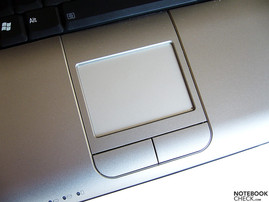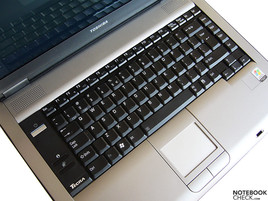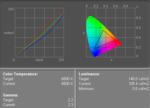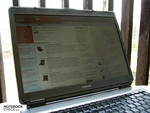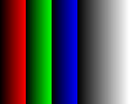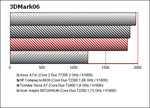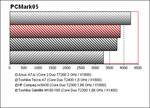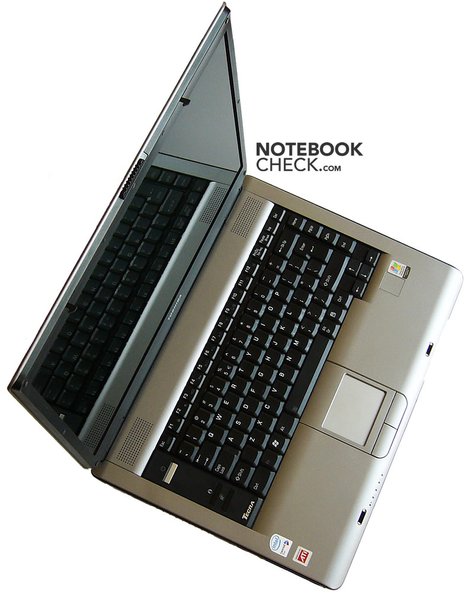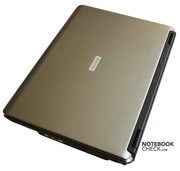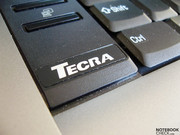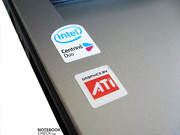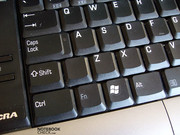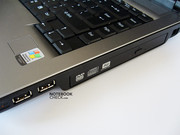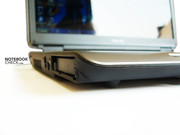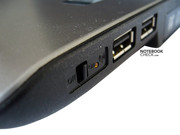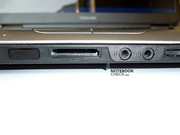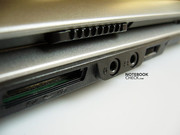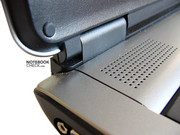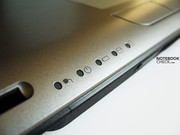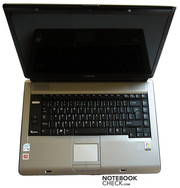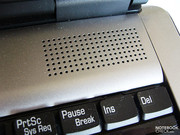Review Toshiba Tecra A7 Notebook
Hard work. Usually office notebooks are not went easy on, on the contrary, they have to faithfully serve their user every day. The reviewed Tecra A7, a representative of the most reliable business notebook class, was apparently worn and already creaked somewhat during handling. Nevertheless, we were quite astonished by this computer's stability. How to explain this apparent contradiction? Well, please read the following article.
Case
Following review is provided by notebookcheck.pl, our Polish editor team.
It is the first time we reviewed a notebook which apparently was in use quite a lot. Seemingly it was a sample for many a test in different editor's offices. Paradoxically, it was favorable for us, as we could check, the Tecra A7's durability after a couple of years of regular usage. Although the run-down notebook creaked at the front part of the base unit (left-hand corner), we can reassure the reader, that, despite of some evident signs of wear, the laptop looks as if it would still serve its user for many years to come. It's hard to express this in words, but you can sense that durability each time you take this computer in your hands. No doubt, the magnesium alloy top case plays a vital role here. This material makes the notebook also relatively light, despite of its size.
Tecra A7 is quite similar to the good old Satellite A100. Both look equally elegant. The fine design of these two Japanese machines won quite a lot of sympathizers over the years. As usual for (older) Toshiba models, the predominant colors are silver and black.
On top of the already mentioned creaking of the base unit there is another minor flaw - the lid's outside can be easily pushed in.
The screen is supported by two large hinges, which pretty much work as they're supposed to. You can only complain about a slight see-saw of the screen after adjusting its position.
Besides the standard interfaces, the Tecra A7 also provides a LPT port, an infrared port, and a PC Card slot, and an ExpressCard slot.
At the front of the notebook on the right side a very ergonomic WireLess is provided. Below the touchpad there is also a fingerprint reader provided, which today is a standard for office notebooks.
Input Devices
The keyboard is generally not bad, but not completely free of some shortcomings. The user will like the fact that it only minimally deflects. The keys are soft, the travel quite long, and despite of that typing feels very comfortable.
However, the layout of the keyboard is not perfect in our view. During fast typing we often mistyped the letter 'A' and hit Caps Lock instead. After getting used to it, this problem fades away, but for some time you have to control your left hand fingers.
The touchpad is quite nice. The dimensions of the pad are (sort of standard with older Toshibas) rather appalling, but its gliding properties, sensitivity and precision are top notch. The pad is quite deep below the top case's surface. The touchpad buttons are mostly flawless, so, you can enjoy using them. They can be used without problems, the only things is that they are a little noisy.
Display
Our Tecra A7 had a glossy 15.4 inch WXGA (1280x800) screen. The same display made by LG.Philips can also be found in the Satellite A100 series. It's notorious drawback is a somewhat dark picture. The brightness is around 100 cd/m², and the measured maximum value amounted to 111.1 cd/m². However, the screen is pleasingly evenly backlit, so, the illuminance is 83%.
| |||||||||||||||||||||||||
Brightness Distribution: 83 %
Contrast: 182:1 (Black: 0.6 cd/m²)
When we brought the laptop outside we experienced what was conceivable on the basis of the undeniable results of the measurements. The glossy screen reflects the user, the surrounding and the sun rays as well. One can hardly accomplish some work, but, by no means you can work efficiently.
Unfortunately, the viewing angles are very narrow. Especially the vertical ones.
Performance
The model which we've tested was equipped with a Intel Core Duo T2400 processor, which is one of the most popular 1st generation dual core mobile CPUs.
The Mobility Radeon X1600 graphic card doesn't really belong to the leading pack of the most potent GPUs, but its performance guarantees some comfortable fun with the newest, demanding games.
The 80GB Fujitsu HDD has a quite good average transfer rate but the access time is not that rosy.
Further information about the video card can be found here or in our comparison of mobile video cards. Detailed information about the Core Duo CPU can be found here.
Please also look at our benchmark list of mobile processors or at our benchmark list of mobile video cards, in order to compare this notebook to other configurations.
| 3DMark 2001SE Standard | 16335 points | |
| 3DMark 03 Standard | 6185 points | |
| 3DMark 05 Standard | 3598 points | |
| 3DMark 06 Score Unknown Setting | 1836 points | |
Help | ||
| PCMark 04 Standard | 5657 points | |
| PCMark 05 Standard | 3978 points | |
Help | ||
Emissions
Loudness
After only a couple minutes of being turned on (and on idle) the fan announces its presence (in relatively loud manner) and doesn't quit after that. It's the same story all over again after a couple of minutes of employing the machine with load - the fan shifts into higher gear and continually maintains the higher revolution speed.
Noise Level
| Idle |
| 34.7 / 40.1 / 38.4 dB(A) |
| HDD |
| 34.9 dB(A) |
| DVD |
| 40.3 / dB(A) |
| Load |
| 0 / 40.1 dB(A) |
 | ||
30 dB silent 40 dB(A) audible 50 dB(A) loud |
||
min: | ||
Temperature
Although we weren't, by any means, lenient towards the Tecra A7, and tried to fatigue it as much as possible, we weren't able to warm up its chassis. Another good sign, which suggests that the material used is in fact magnesium alloy. The maximum measured on the top case was only 38°C. And also at the bottom side the temperature never exceeded 40 degrees Celsius.
Upper side
palmwrist: 29.3°C max: 37.9°C avg: 31.4°C
Bottom side
max: 39.5°C avg: 33.0°C
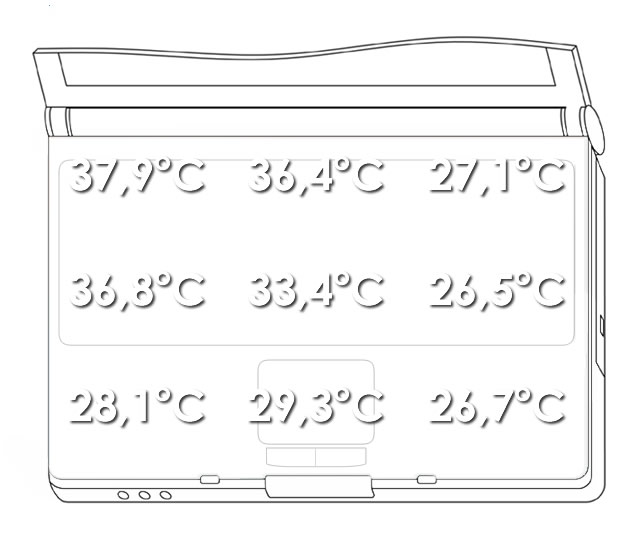
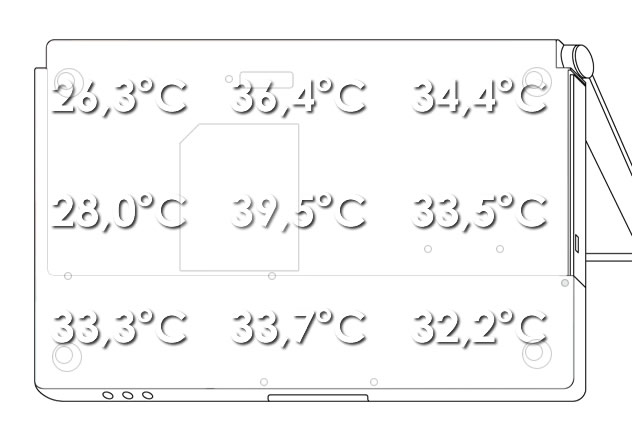
Speakers
Although Toshiba doesn't make a fuss about it (there is no sign of any sort on the chassis), the Tecra A7 is equipped with Harman Kardon speakers. Hidden behind an inconspicuous perforated cover, they provide clear but not too loud sound.
Battery Runtime
One of the few major complaints about Toshiba laptops is invariably the low battery capacity. Equipped with a 4000mAh battery, the battery run time is between an hour (full load) and about two hours.
| Off / Standby | |
| Idle | |
| Load |
|
Verdict
Despite of the before mentioned creaking, the somewhat worn Tecra A7 quite impressed us with its seemingly endless vitality. This laptop really seems very robust, and is that solid, one would possibly need to make a serious effort in order to damage it.
The worst part, on the other hand, is the lousy screen by LG.Philips, which has a rightly has a bad reputation. Still, it seems to be loved by Toshiba without a common-sense reason (we assume that this is a price decision). Its brightness is very low, and the viewing angles are quite horrible. Oh, well...
Thanks to our partners of Notebookcheck Polen, who reviewed this notebook.


 Deutsch
Deutsch English
English Español
Español Français
Français Italiano
Italiano Nederlands
Nederlands Polski
Polski Português
Português Русский
Русский Türkçe
Türkçe Svenska
Svenska Chinese
Chinese Magyar
Magyar




